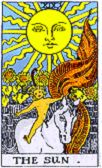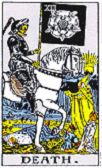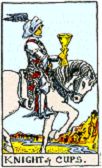


the archetypal mythology of horses
Copyright
2004-2022 Beverley Kane, MD
Page 15 of 20
HORSES IN THE TAROT—MYSTICAL CHIVALRY
The Tarot is a deck of 78 cards that, differentiating their upright from
reversed positions, depict 156 conditions of the psyche. The history of
the Tarot is obscured by ghost stories until the appearance of Italian
decks in the Middle Ages. In the absence of any objectifiable history,
the numerous decks must be taken at face value suggesting a
syncretism of multiple mythologies. Prior to the many PhotoShopped
desktop decks with pop and high tech imagery, the images and
traditions of the classical decks have been eclectically pagan,
Christian, Arthurian, alchemical, and Kabalistic.
In the Waite-Coleman Tarot, one of the most commonly used for divination,
there are seven cards depicting horses: The Sun, Death, the 4 Knights, and the 6 of
Wands. In all the illustrations, the horses are mounted, in portrayals of physical and
metaphysical transport.
In The Sun and Death, horses carry respectively the youngest
person and the oldest person in the Tarot—the crowned and
conquering child of the new aeon and the grim reaper himself. As in
many horse myths, the horse in the Death card is a psychopomp, one
who carries dead souls to their final resting place. The horses
contribute to the Tarot's framework of transition, cycles, and process.
In essence, the Tarot is like the Book of Changes, the I Ching, where
the only constant is change. The Death card in the Tarot, as death in
dreams, is one of the most reliable indicators and harbingers of
profound psychospiritual transformation.
Each of the four court cards represents the querent's evolving use of the energies
represented by the suits— wands (intuition), cups (emotions), swords (intellect), and
pentacles (sensation). Knights in the Tarot signify energies that the querent is in process
of integrating but has not fully mastered. The Knight's use of energy is,
in the chivalric sense, for the sake of the Other—the fragmented self
split off from the integrating ego who has not yet learned the mature
and confident use of that energy. In the mythos of chivalry, with its
values of courage, courtesy, honesty, courtly love, and service, the
Knight seeks his fortune in uncharted regions of consciousness. For
Waite, a 19th century mystic who was steeped in the esoteric
significance of the Holy Grail and who wrote books on the Arthurian
legends, Knights and their horses represent the Hero's journey to
spiritual wholeness.
SUMMARY
Horses are ubiquitous in the fables and legends of many different cultures. Like other
mythical figures, horses dramatize the Jungian psychological archetypes—roles or


